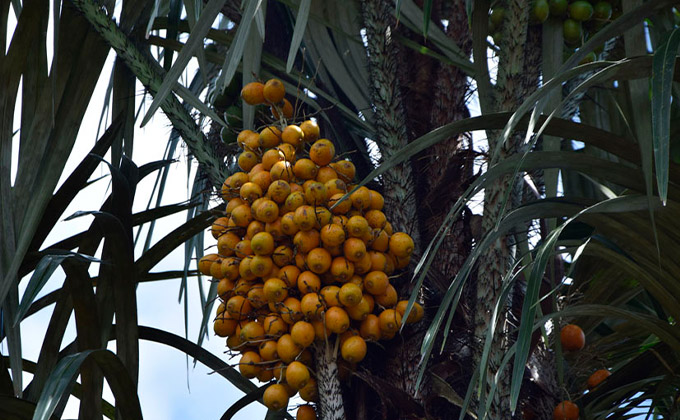Rainforest Products
- OILS
- Açaí (Euterpe oleracea)
- Andiroba (Carapa guianensis)
- Babaçu (Orbignya oleifera)
- Bacaba (Oenocarps distichus)
- Buriti (Mauritia flexuosa)
- Brazilnut (Bertholletia excelsa)
- Guava (Psidium guajava)
- Soursop (Annona muricata)
- Passionfruit (Passiflora edulis)
- Patauá (Oenocarpus bataua)
- Pequi (Cariocar brasiliensis)
- Pracaxi (Pentaclethra macroloba)
- Tucumã pulp (Astrocaryum vulgare)
- BUTTERS
- Bacuri (Platonia insignis)
- Cupuaçu (Theobroma grandiflorum)
- Murumuru (Astrocaryum muru-muru)
- Tucumã kernel (Astrocaryum vulgare)
- Ucuuba (Virola surinamensis)
- RESINS AND WAXES
- Copaiba (Copaifera officinalis)
- Breu Branco (Protium heptaphyllum)
- Carnaúba (Copernicia prunifera)
- CLAYS
- White-amazonian
- Pink
- Red
- Yellow
- Black
- Green
- EXTRACTS
- Jambu (Spilanthes oleracea)
- Mulateiro (Calycophyllum spruceanum)
- Urucum (Bixina orellana)
- Tonka Bean (Dipteryx odorata)
- HAIR CARE SPECIALITIES
- NUTRIBALM 40 CD - capilar moisturizer
- CM40CT - Cuticle Cement
- TP40 BIOCIMENT - Low Porosity Hair
- BERRENSHOT 20DC - Straighten Hair Naturally
- THERMO-SHIELD 40 PT - Restoring Hair Color
- CHEMSHIELD 30 DQ - Protection Chemical Hair
- CURLER ACT 30 - Curly Hair
- PEROXIBLOCK 50SS - Restoring Hair Color
- SKIN CARE SPECIALITIES
- LINOPALM 70 AS - Anti-aging
- NOCAPTONE DMT - Anti-celulite
- BTM US 30 - Anti Strech Marks
- ANGEKTASE 40PP - pos-peeling
- ESSENTIAL OILS
- Copaiba Essential Oil
- Breu Branco Essential Oil
- Copaíba Resin
Tucumã butter Astrocaryum vulgare
Synonym: awara
CAS# 98143-57-8

HARVESTING SEASON

FATTY ACID COMPOSITION AND PHYSICAL-CHEMICAL DATA
Tucuma butter is very similar to palm kernel butter in appearance, consistency and property but with higher and favorable melting point. It is known that butter with lauric acid has a key role in immune system function and prevention of various diseases. Due to its grease composition and unsaponifiable matter Tucuma butter forms a protective film on the skin and hair without causing damage to the lipid exchange.
Forms a transparent protective film on the skin, similar silicone without clogging the pores. The lipid exchange of the skin is not damaged and works well on dry skin and even on oily ones.
Tucuma butter are excellent for formulations for dry hair with split ends. Penetrates the cuticle of the hair to replace the loss of structural lipids and replenish moisture, giving back the natural elasticity, leaving them soft, strong and silky. Highly recommended for formation of curled hair and regeneration of ethnic hair.

POPULAR USAGE
The fiber has many uses; the leaves provide a very resistant fiber, ideal for basketry, the seeds are used in handicrafts, and the fruits are consumed raw or in the form of a juice called “wine of Tucuma,” which is mixed with water or made into ice cream. In addition, the pulp is very nutritious, containing one of the highest concentrations of provitamin A “beta-carotene” (52 milligrams per 100 g pulp), equaling the value found in the pulp of buriti. In comparison, the concentration of beta carotene in carrots is 6.6 milligrams/100 g pulp. Its oil is used in cooking and in massages.

ECOLOGY
This species is native to the Amazonian region, possibly to the state of Pará, where it has its distribution center, and reaches French Guiana and Suriname. It is a characteristic palm of terra firme, low vegetation cover, or even open fields. There are two species of Tucuma in the Amazon, Tucuma-do-para (Astocaryum vulgare) and the Tucuma-do-amazonas (Astrocaryum tucuma). The tree of Tucuma-do-para is 10 to 15 m in height and regenerates quickly by growing multiple stems, while the Tucuma-do-amazonas can reach 25 m in height and forms a solitary trunk. Its fruits are also larger, and its pulp is fleshier, less fibrous, and less sweet than the pulp of Tucuma-do-para.
The Tucuma palm is considered a pioneer plant of aggressive growth, can grow new shoots after a fire, and mainly inhabits secondary forests and pastures. Seeds take up to 2 years to germinate. The plants grow slowly in cultivation and produce fruits after eight years. Some isolated oil palm (Elaeis guineensis) growers are beginning to replace the oil palm with Tucuma even without receiving support from research institutions to improve this species genetically. Its resistance to diseases and high productivity make this species an alternative for biodiesel production since the operating costs of an orderly plantation are much less than that of the oil palm.
The seed of Tucuma-do-para is covered externally with oily orange pulp. On average, the fruit weighs 30 g; 34% corresponds to the external pulp, with 14% to 16% of the oil when raw. A mature tree can produce up to 50 kg of fruits annually (25 kg per tree on average), corresponding to 2.5 kg of pulp and 1.5 kg of seed oil. Four hundred palm clusters can be planted in one hectare, each with three trunks. In total, this equals 1200 palm trunks and will result in 4.8 tons of fatty material per hectare, more than the oil palm, Elaeis guineensis, which produces only 4 tons of oil on average per hectare per year (assuming a harvest of 20 tons of fruits and an extraction of 22% oil). The advantage of Tucuma-do-para is that it forms clusters that do not need to be replanted, which is not the case for Elaeis guineensis.
REFERENCES
ALMEIDA, A. G. et. al: Beta caroteno na prática clínica, Instituto de Metabolismo e Nutrição, http://www.nutricaoclinica.com.br/beta-caroteno-na-pratica-clinica.html (acessado 17/11/2009)
BORA, P. S. et. al.: Characterization of the oil and protein fractions of tucuma (Astrocaryum vulgare Mart) fruit. 2001, Ciencia y Technologia Alimentaria, Ourense, Espanha, v. 3, n. 2, p. 111-116.
CALVACANTE, P. B.: Frutas Comestíveis da Amazônia, 1996, 6a Ed , Edições Cejup – Museu Paraense Emílio Goeldi, Belém.
MORAIS, L. : Banco de Dados Sobre Espécies Oleaginosas da Amazônia, não-publicado.
© All rights reserved / Privacy Policy / Terms of use



